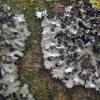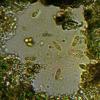
21-12-2025 21:32
Pol DebaenstHello, Garden, Burgweg 19, Veurne, BelgiumOn 10/1

22-12-2025 00:47
Patrice TANCHAUDBonsoir, récolte à proximité du milieu dunaire

21-12-2025 21:40
Isabelle CharissouBonjour, j'aimerais connaitre les références de

21-12-2025 21:31
Pol DebaenstHello, Garden, Burgweg 19, Veurne, BelgiumOn 10/1

21-12-2025 21:31
Pol DebaenstHello, Garden, Burgweg 19, Veurne, BelgiumOn 10/1

20-12-2025 23:08
Patrice TANCHAUDBonsoir, récolte sur sol sablonneux dans l'arri�

21-12-2025 09:32
Hello.A tiny ascomycete found embedded in wood in

20-12-2025 15:47
Mirek GrycHi.These grew on pine wood that was heavily covere
 Hello all,
Hello all, I wondered if anyone might have details of the spore sizes etc for Lichenochora hyperphysciae, a lichenicolous fungus on Hyperphyscia adglutinata?
With regards,
Jenny

The reason for the above request is that I found a lichenicolous fungus forming abundant black perithecia on the lobes of Hyperphyscia adglutinata. Spores were hyaline, 1-septate, 12.5-15(-17) x 5-6 µm and somewhat 'sole-shaped'.
I reached Lichenochora using the 2010 draft keys to the Lichenicolous Fungi
of Great Britain, Ireland, the Channel Islands, Iberian Peninsula, and Canary Islands - they give details of Lichenochora obscuroides (with slightly larger spores) on Phaeophyscia but nothing for Hyperphyscia adglutinata.
Googling produced a 2011 record for Lichenochora hyperphysciae on Hyperphyscia adglutinata:
"Etayo, J. 2011. Lichenochora hyperphysciae, a new lichenicolous fungus found in Mexico and Spain. Bibliotheca Lichenologica 106:53–56. [New species: Lichenochora hyperphysciae Etayo (on Hyperphyscia adglutinata).]. "
I'm hoping I'm on the right track which is why I wondered if anyone might have access to this publication with the spore size etc for Lichenochora hyperphysciae?
With regards,
Jenny
Hi Jenny,
It's perhaps not a Lichenochora. Have you more informations (asci, paraphyses s.l., ...) ?
You should ask directly to Javier informations about L. hyperphysciae.
Alain

Thanks for your reply but no paraphyses that I could see and only the indistinct asci that are (just) visible in the microphoto. It was a very bad section cut with the help of a propped torch as the lightbulb in my dissecting 'scope had just blown.....!
As I'm waiting for a replacement bulb I'll email the images to Brian Coppins and see what he might suggest.
With regards,
Jenny
Ok, wait and see...
Stil many solutions to my mind, but one first point is to describe : ascomata, is it perithecia ? With such ascospores I would think more at other genus than Lichenochora.
Keep in touch,
Alain

Now I can see what I'm looking at the host is Phaeophyscia orbicularis and there are ascomata with indistinct margins rather than perithecia.
No wonder the spores looked arthoniod - my spore measurements slightly longer than those given in the key but Arthonia phaeophysciae?
My apologies for posting before I was able to properly examine the specimen,
Jenny
Hi Jenny,
Don't worry, identify lichen + lichenicolous fungi is not easy !
Alain

It was my first idea.
Nevertheless, at least check if hymenium is J+ (red wine).
Alain

excuse me by my delay. Yes, it seemed Arthonia phaeophysciae. Lichenochora spores are very typical with a very reduced lower cell and the fungus forms galls.
If you are interested in the paper on Lichenochora I can send the paper to your email.

My address is seawright.jenny@gmail.com
With regards,
Jenny
Dear Javier,
I would appreciate the copy too ...
Alain


